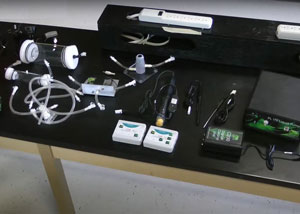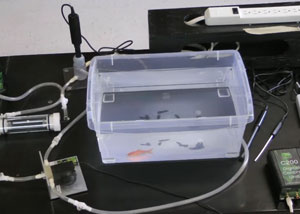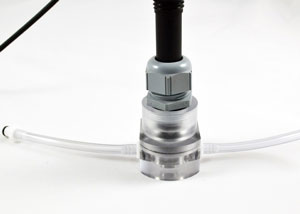Q-Box AQUA Aquatic Respirometry Package
measurements of metabolic rates (VO2) in aquatic animals
overview
The Q-Box AQUA Aquatic Respirometry Package is an advanced system designed for precise measurements of metabolic rates (VO2) in aquatic animals. This package allows researchers to study both vertebrates and invertebrates by monitoring the reduction of dissolved oxygen (DO) inside the respirometry chamber. The Q-Box AQUA uses the principle of intermittent flow respirometry and can monitor up to four aquatic chambers/samples simultaneously, ensuring consistent experimental conditions across all chambers.
features
- Optical DO Probe
- Small Respirometry Chamber (140ml, 3.8cm ID, 15.3cm long)
- Large Respirometry Chamber (660ml, 8.2cm ID, 16.7 cm long)
- mini-AQUA chamber (9ml, 1.6 cm ID, 4.5 cm long)
- micro-chamber (1.23ml, 1.5 cm ID, 0.85cm depth) in mini-AQUA
- Temperature & Salinity Probe for Water Bath
- Liquid Pump (1 LPM or 0.1LPM in mini-AQUA) & 3-Way Valve
- Digital Control Unit for 3-Way Valve Control
- 6 Channel Data Interface
- Data Acquisition Software
- Absolute Pressure Sensor
- Rugged Weatherproof Case
applications
- Aquatic Respirometry Studies: Ideal for measuring metabolic rates in aquatic environments.
- Aquatic Vertebrate and Invertebrate Research: Suitable for a wide range of species.
- Lab and Field Studies: Optional battery pack allows for fieldwork.
Q-Box AQUA operation
The animal is placed in a respirometry chamber and the decrease in dissolved O2 due to consumption by the animal is measured. Dissolved Oxygen data corrected for salinity, temperature and pressure is displayed in the software and used to calculate on the go values of oxygen consumption rate (VO2). Measurements are made sequentially without removing the animal from the chamber. The chamber is flushed with fresh water between measurements. These intermittent flow measurements of VO2 overcome disadvantages of continuous closed respirometry where dissolved O2 level in the chamber may decrease to a hypoxic level. All of the components of the Q-Box AQUA Package are housed in a rugged weather proof case for easy transport and storage.
During an experiment, water is circulated through the animal chamber and the flow-through vessel with the optical DO probe by the liquid pump. A 3-way valve, controlled by Digital Control Unit (DCU), and the software determines if the system is in circulation or flushing mode. During the circulation mode, respiration measurements are made and during flush mode, the animal chamber is being flushed with oxygenated water from the water bath. The circulation-flush cycle is repeated until the experiment is terminated. The time of the flush and circulation phase are selected by the user in the software.
mini-AQUA for small samples
The mini-AQUA package is specifically designed for small aquatic samples, such as small fish and insect larvae (~1g). It includes a modified version of the Q-Box AQUA with a smaller respirometer chamber (9ml) and components for a more compact system. This package also features a micro-chamber (1.23ml) with a DO probe for measuring VO2 in very small samples, such as larvae and juvenile fish under 0.5g. The micro-chamber operates in an intermittent stop-flow mode, enhancing the sensitivity and resolution of the system.
references
- Hudson, D. H. (2021). Metabolic response to temperature stress in the Colombian freshwater crab *Neostrengeria macropa* (H. Milne Edwards 1853). *Journal of Crustacean Biology*, 41(1), 1-7. doi:10.1093/jcbiol/ruab002
- Rahi, L. (2021). Temperature-induced changes in physiological traits and expression of selected candidate genes in black tiger shrimp (*Penaeus monodon*) larvae. *Aquaculture Reports*, 19. doi:10.1016/j.aqrep.2021.100620
- Rahi, L., et al. (2020). Impact of salinity changes on growth, oxygen consumption, and gene expression in the orange mud crab (*Scylla olivacea*). *Aquaculture Research*, 51, 4290-4301. doi:10.1111/are.14772
- Lucey, N. M., et al. (2020). Oxygen-mediated plasticity confers hypoxia tolerance in a corallivorous polychaete. *Ecology and Evolution*, 10(3), 1145-1157. doi:10.1002/ece3.5929
- Huang, M., et al. (2020). Influence of Atrazine on the growth, development, and oxygen consumption of *Pelophylax nigromaculatus* tadpoles. *Nature Environment and Pollution Technology*, 19(4), 1311-1317.
- Lamarre, S. G., et al. (2019). Interrelationship between contractility, protein synthesis, and metabolism in juvenile cuttlefish (*Sepia officinalis*). *Frontiers in Physiology*, 10, 1051. doi:10.3389/fphys.2019.01051
- Rangel, R. E., & Johnson, D. W. (2018). Metabolic responses to temperature in a sedentary reef fish, the bluebanded goby (*Lythrypnus dalli*). *Journal of Experimental Marine Biology and Ecology*, 501, 83-89. doi:10.1016/j.jembe.2017.12.002
- Black, M. N., et al. (2017). Environmentally relevant concentrations of amine-functionalized copper nanoparticles exhibit different bioactivity mechanisms in *Fundulus heteroclitus* in fresh and brackish water. *Nanotoxicology*, 11(8), 1070-1085. doi:10.1080/17435390.2017.1395097
- Keogh, C. L., et al. (2017). The double edge to parasite escape: invasive host is less infected but more infectable. *Ecology*, 98(9), 2241-2247. doi:10.1002/ecy.1882
- Callaghan, N. I., et al. (2016). Zinc oxide nanoparticles trigger cardiorespiratory stress and reduce aerobic scope in the white sucker (*Catostomus commersonii*). *NanoImpact*, 2, 29-37. doi:10.1016/j.impact.2016.01.002
- Lamarre, S. G., et al. (2016). Metabolic rate and protein turnover in food-deprived cuttlefish (*Sepia officinalis*). *American Journal of Physiology-Regulatory, Integrative and Comparative Physiology*, 310(11), R1160-R1168. doi:10.1152/ajpregu.00018.2016
- Bessemer, R. A., et al. (2015). Cardiorespiratory toxicity of zinc oxide nanoparticles in the freshwater fish *Catostomus commersonii*. *Nanotoxicology*, 9(7), 861-870. doi:10.3109/17435390.2015.1014514
specifications
| feature | specification |
|---|---|
| G217 Large Respiration Chamber: | 660ml (8.2cm ID, 16.7cm long) |
| G216 Small Respiration Chamber: | 140ml (3.8cm ID, 15.3cm long) |
| G210 Mini-AQUA Chamber: | 9ml (1.6cm ID, 4.5cm long) |
| G223 Mini-AQUA Micro-Chamber: | 1.23ml (1.5cm ID, 0.85cm depth) |
| S122 Optical DO Probe: | For precise oxygen measurements |
| A260 Flow-Through Vessel: | For DO probe integration |
| PL175 Liquid Pump: | 1 LPM flow rate |
| PL100 Liquid Pump: | 0.1 LPM for mini-AQUA |
| A236 Three-Way Valve: | For directing water flow |
| C200 Digital Control Unit: | For managing the three-way valve |
| A750 Simple Plastic Water Bath: | For temperature control |
| S132 Temperature Probe: | For accurate water temperature readings |
| S181 Absolute Pressure Sensor: | For additional environmental monitoring |
| S130 Salinity Probe: | For measuring water salinity |
| 6 Channel Data Acquisition Interface: | Two C610 units |
| C901 Software and C404 Experimental File: | For data collection and analysis |
| Rugged Weatherproof Case: | For protection and portability |
| Q-Box AQUA Accessory Kit: | Includes tubing, connectors, and filters |
| User Manual: | Comprehensive guide for setup and operation |
| A249 Battery Pack (optional): | For field studies |
video
For a visual demonstration of the Q-Box AQUA system, please watch the video





